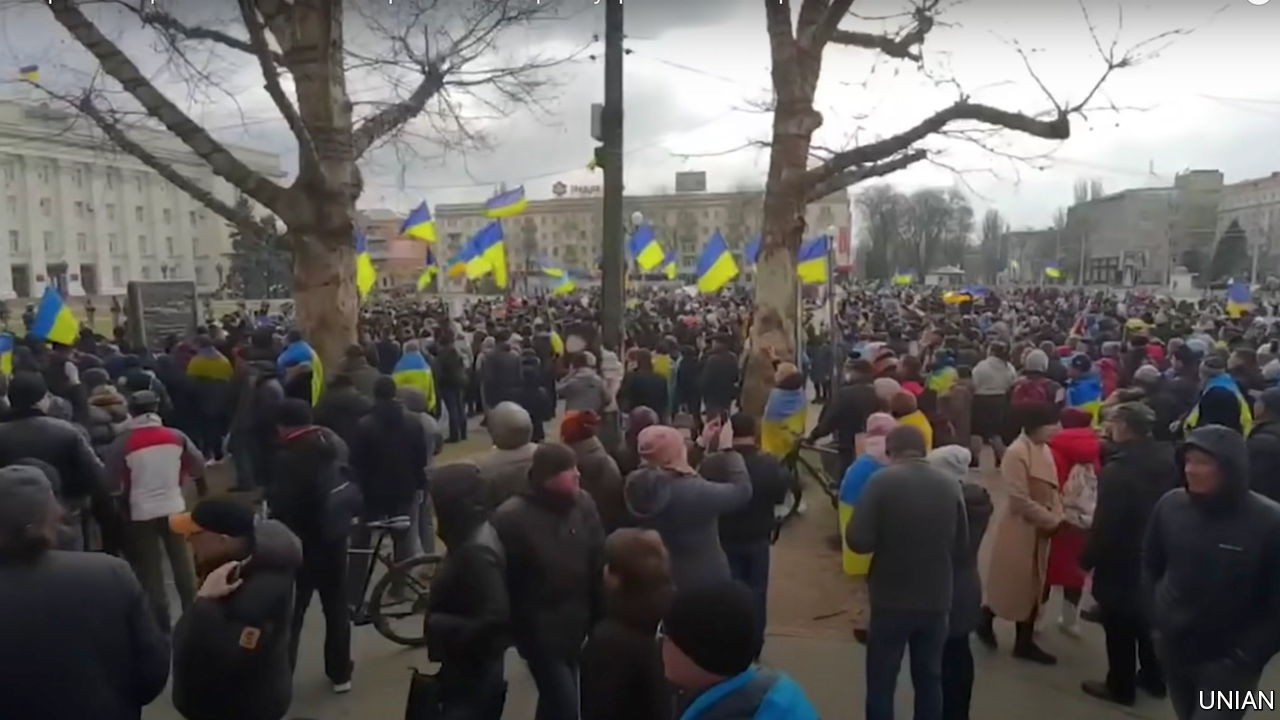THE TANKS that left Crimea on February 24th took five days to get to the centre of Kherson, 120km or so to the north-west. But on March 1st they reached the centre of the city—normally a sleepy, provincial place, similar in population and distance from the sea to Bordeaux, but now a strategically important part of Russia’s attempt to take control of a corridor along Ukraine’s entire coast. Russian state media heralded the fall of the city as the campaign’s first “liberation”.
The people of Kherson were having none of it. They met the soldiers waving Ukrainian flags and screamed at them to leave. Some of them stood in the way of tanks, refusing to move when soldiers fired warning shots. The city’s mayor and the governor of the Kherson oblast, both of them in effect hostages, insisted that they would take orders only from Kyiv. A week after the occupation began they were sticking to their guns.
Spirited resistance across Ukraine—from Berdyansk on the Azov Sea to Sumy in the north-east—has been backed up by a widespread unwillingness to acquiesce in the parts of the country where Ukraine has lost control. There is no evidence of Vladimir Putin’s soldiers being welcomed anywhere. The mood is generally one of contempt. In Konotop, a town in Sumy oblast, a local woman was filmed asking a Russian tank-driver if he knew about the town’s literary association with the occult. “Every second woman is a witch here,” she told him. “Tomorrow you won’t be able to get your dick to stand up.”
The invading Russians appear ill-prepared for this. This is not that surprising; they have proved ill-prepared for a lot of fairly predictable things. But they do seem to have anticipated a less hostile reception. Mr Putin has told his nation that Ukraine’s drug-addled neo-Nazi elite has been perpetrating genocide and that Ukrainians, especially Russian-speaking ones, needed saving. Film of prisoners of war shows that at least some of the rank and file expected to be welcomed.
In Kherson, Russia has turned off Ukrainian television broadcasts and positioned artillery batteries in the centre of town, but unabashed pro-Ukrainian rallies have continued daily. Initially flummoxed, on March 9th Russian forces detained over 400 protesters in a violent escalation that Ukrainian authorities said represented the beginning of a new repressive regime.
Alexander Mogilinkov, one of thousands to attend the rallies, said by phone on March 8th that the violence of the Russian army has galvanised people in town. Protesters are nervous, he says, and they face a new threat they do not understand. But they are even more fearful of the repression and poverty that Mr Putin has imposed on the nearby regions of Donetsk and Luhansk, which have been controlled by Russia since 2014.
There are ways to win over occupied populations, for example by mending some of the damage and meeting some of their needs. Philip Ingram, once a colonel in British military intelligence, says that civil engineers, medical support and civil-affairs staff are essentials for a successful occupying force. But this has not been an area in which Russian forces have ever excelled. “They are not designed, from a military perspective, to occupy and rebuild,” he says. “Just hold and destroy.”
Locals report an invading army that is hungry, looting, and “out of control”. Viktor Merinkov, the director of a boarding school for deaf children in the centre of Kherson, says the disrespectful behaviour of soldiers had made them no friends. “As far as locals are concerned, Russia has become a by-word for fascist invaders,” he says. His wife Valentina intervenes on the call to urge him to temper his language; the couple have responsibility for eight young students, stranded in Kherson, she reminds him.
The effort to instil fear and thereby compliance is likely to be stepped up as Russia looks to regain the upper hand. On March 8th the Ukrainian armed forces claimed that Russia had begun sending in security operatives to “work” the local population in Kherson. That would indicate an approach to dissent not dissimilar to that already employed in Crimea. Intelligence services there have a tried and tested approach, says Anton Naumlyuk, a Russian journalist who has reported from the annexed peninsula since 2016, which differs little from schemes used by Tsarist political police to sniff out revolutionaries at the start of the 20th century. “First, they map networks to understand who the real opinion leaders are, and they target them. If people co-operate, fine. If not, they start to disappear.” Crimea SOS, a non-governmental organisation, says at least 24 men have vanished in Crimea since 2014.
The Russians may have already started using such schemes in Kherson. On March 7th local media suggested that Oleksandr Tarasov, an activist, had been reported missing after that evening’s protest rally. Mr Tarasov emerged 24 hours later, apparently distressed, and said in a bizarre, filmed “confession” that he had been working for the Ukrainian security services to destabilise Kherson.
Elsewhere in Ukraine, reports are emerging alleging the use of extreme violence against local populations in areas under notional Russian control. The claims include tanks being deliberately rammed into houses, mock executions, hostage-taking, extrajudicial killing and sexual violence. The resistance of ordinary Ukrainian people is strong, but it might not survive such tactics for long.
Our recent coverage of the Ukraine crisis can be found here
